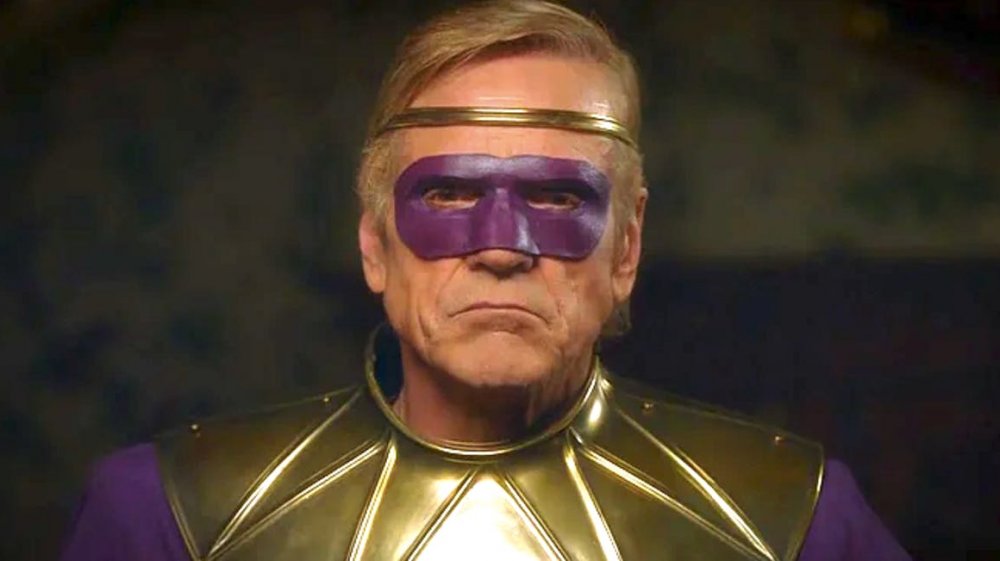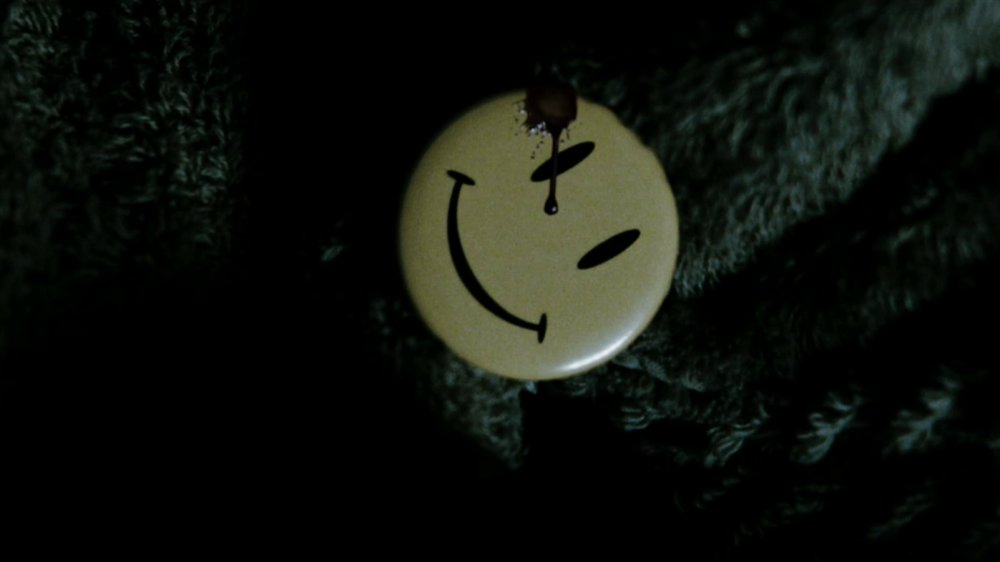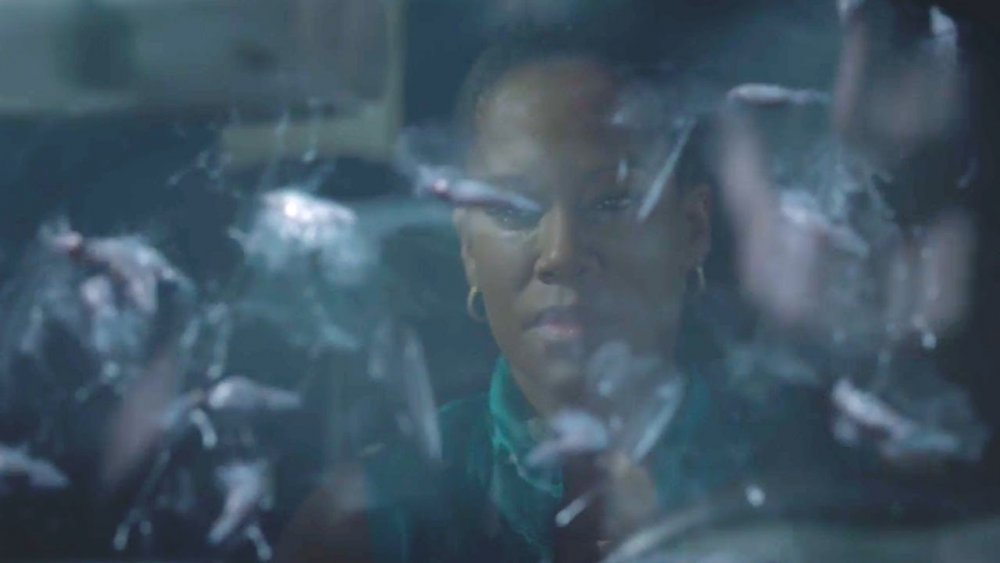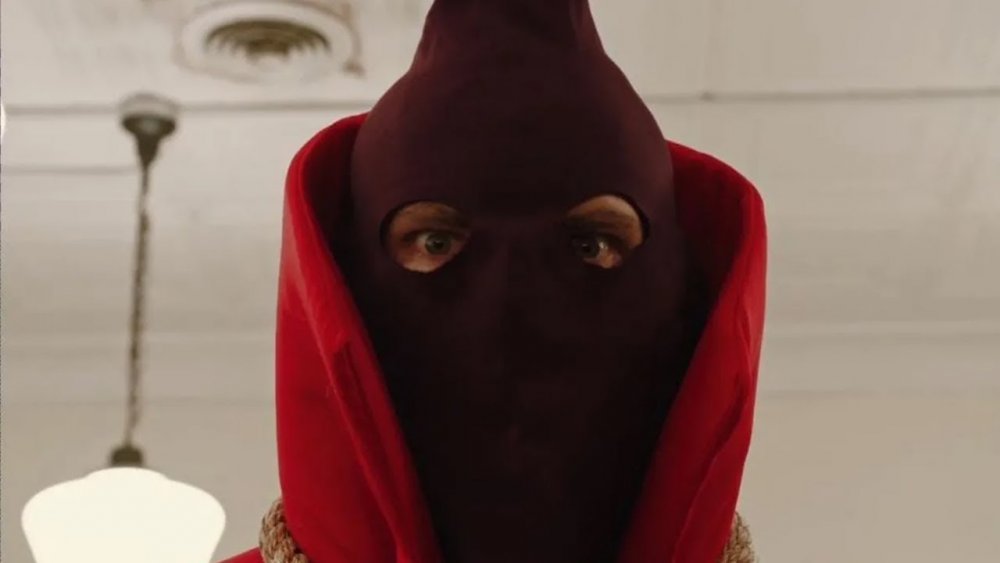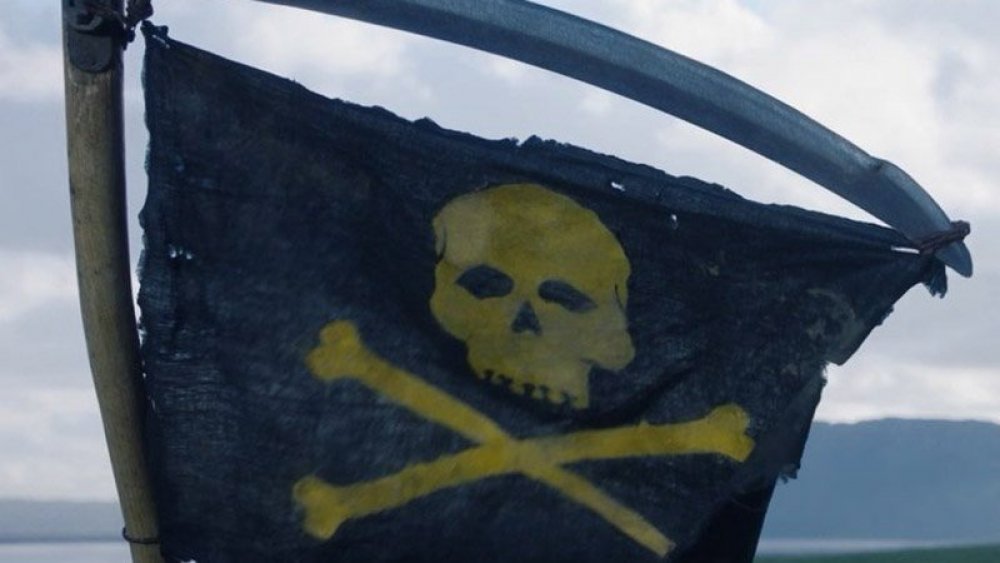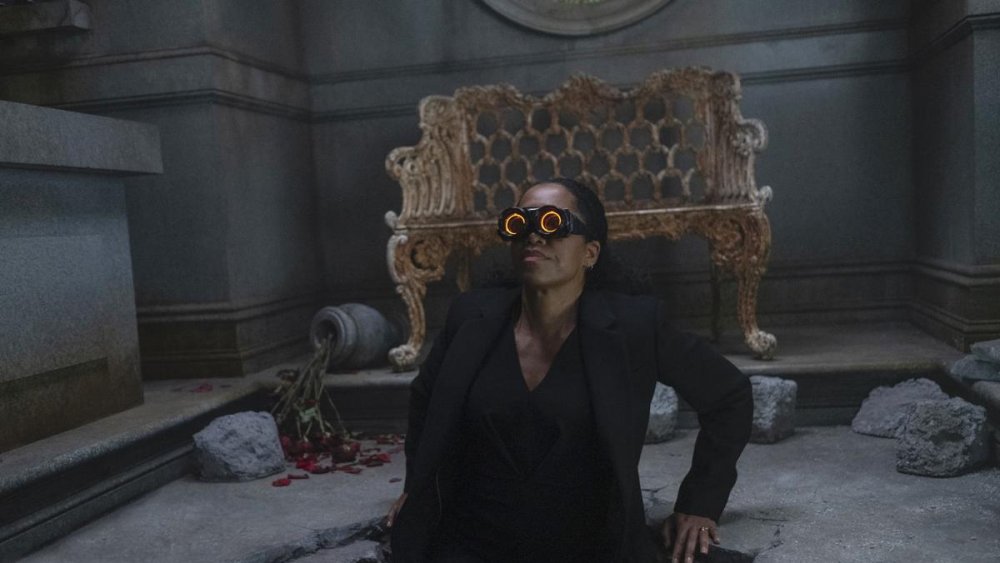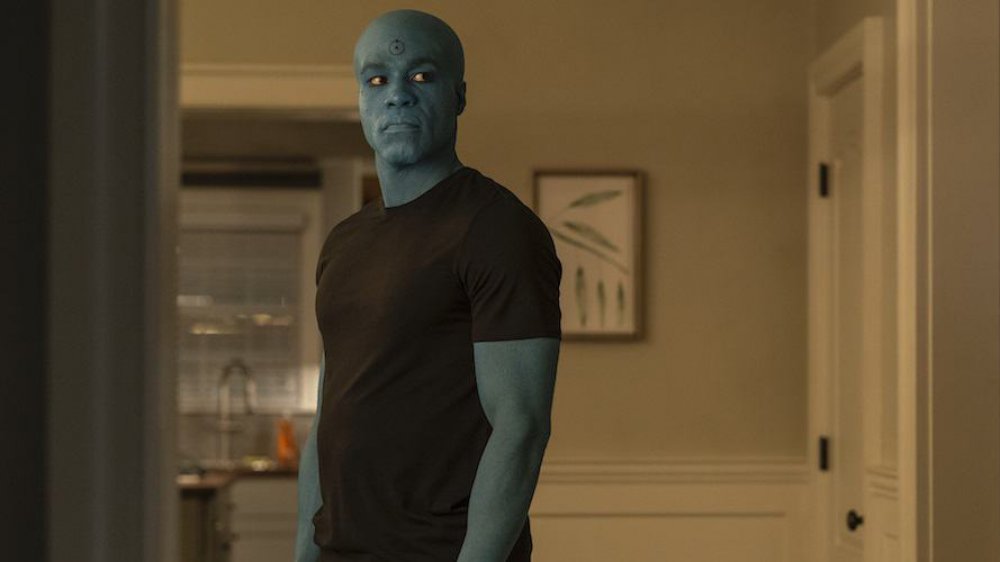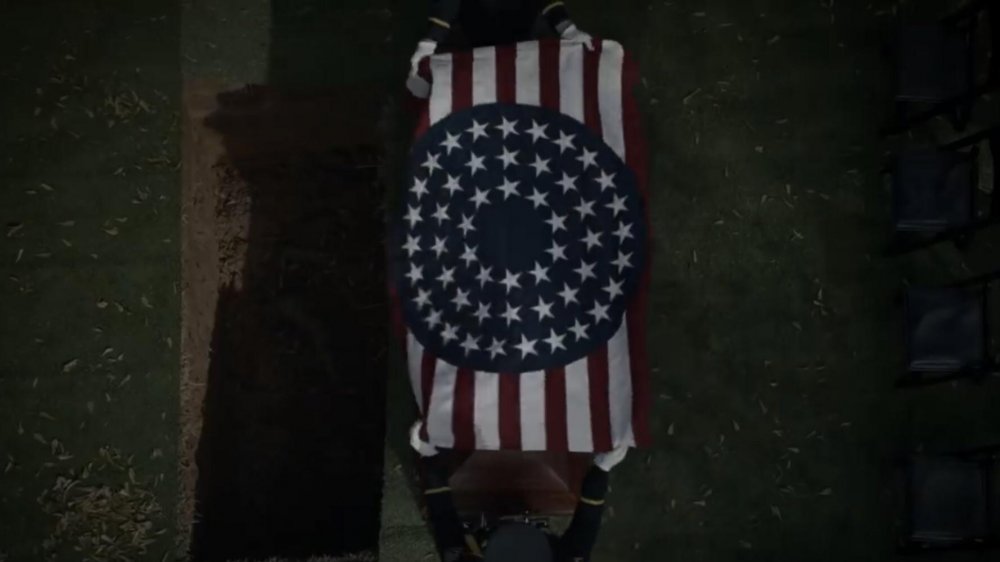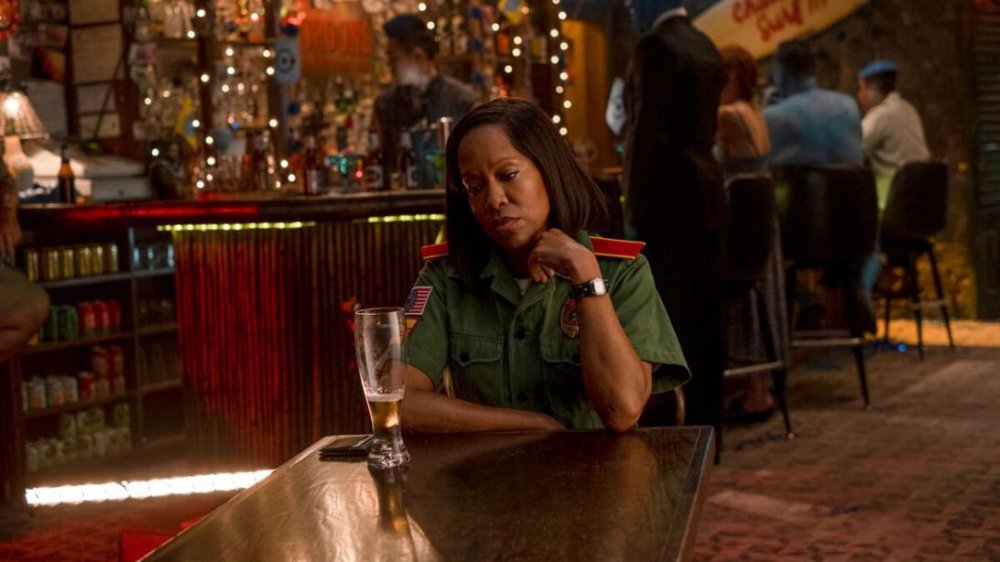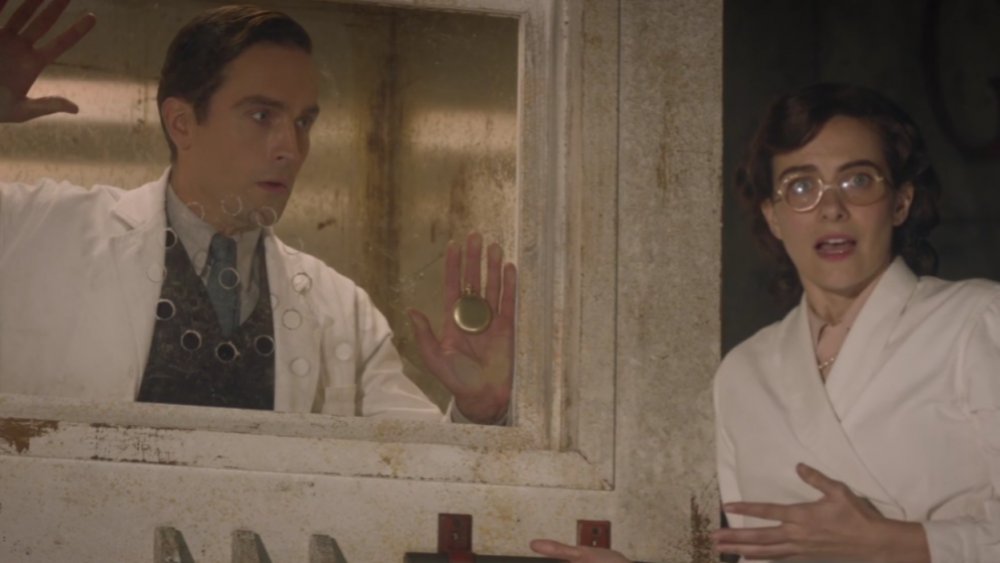Easter Eggs You Missed In HBO's Watchmen Season 1
After Zack Snyder's ultimately disappointing 2009 film adaptation of Alan Moore and Dave Gibbons' classic Watchmen, fans thought they'd never get to see a better take on the source material. Luckily, a decade later, HBO greenlighted a sequel series from Damon Lindelof.
Set well after the events of the original Watchmen narrative, this chapter is set primarily in Tulsa, Oklahoma — though it employs plenty of flashbacks and scenes in other places — and though it features some characters from the original series, like Ozymandias, Dr. Manhattan, and Silk Spectre, it tells a mostly new story. Led by Regina King as Angela Abar, this story sees a world in which the police dress in costume to protect themselves from a terrorist group known as the Seventh Kavalry, who seek anarchy and the destruction of the police force. Meanwhile, our favorite Watchmen characters have chosen new paths; Adrian Veidt (Jeremy Irons), otherwise known as Ozymandias, lives in solitude (kind of), and Laurie Juspeczyk (Jean Smart), whom you might know as Silk Spectre, is now working for the FBI.
As a bridge between the comics and an entirely new story, HBO's Watchmen forges its own path, but it doesn't forget where it came from. As a result, it's packed full of fun, covert references throughout its first season — so if you're curious, here are some of the Easter eggs you might have missed. Spoilers to follow!
Literal eggs
"Easter eggs" tends to be a catchall term for small references within films or television shows, but Watchmen features a ton of actual eggs, making references to the comic visually as well as rewarding fans. As a literal symbol of fertility and rebirth, it makes sense that actual eggs would factor into Watchmen somehow, and there's plenty of examples.
Watchmen's pilot, "It's Summer and We're Running Out of Time," features maybe the most obvious Easter egg in the entire show; as Angela cracks eggs into a bowl, they form the smiley face you might recognize from Watchmen's original comics cover. Beyond that, there are plenty of other instances of eggs throughout the show. Dr. Manhattan conjures and drinks one during his first date with Angela after he pours it into his beer, and in the fourth episode of the show, "If You Don't Like My Story, Write Your Own," a couple who later gets some much-needed fertility help from the mysterious Lady Trieu (Hong Chau) pick up spilled eggs on their porch as the audience first meets them. Finally, during the series finale, Angela arrives home after a harrowing night to find an entire carton of eggs broken on her floor, leading to an important discovery; one egg is left intact, which Dr. Manhattan left behind after his death in order to give Angela his powers. Angela eats the egg as instructed, but whether she has his powers remains to be seen.
A fateful blood spatter
The source material for HBO's Watchmen is beloved for many reasons, but one of its most iconic emblems is an oft-pictured smiley face button with a blood spatter across its forehead. Naturally, Lindelof and his crew found a way to work this image into the show.
The first episode of Watchmen opens on a horrific, very real historical event known as the Tulsa Race Riot of 1921, which remains one of the most devastating instances of racial violence in the history of this country. White citizens attacked Greenwood, a primarily African-American area, looting, robbing, and killing with abandon. In Watchmen's universe, descendants of the attack were paid reparations (causing resentment amongst white supremacists), which decidedly did not happen in our timeline.
In the midst of this all too real historic tragedy, the show sneaks in a terrible, tragic reminder of Watchmen's button — a blood spatter on the head of a young boy that perfectly mimics the smiley face. A similar blood splatter can be spotted later, on Judd's badge.
Squids everywhere
Casual viewers of the series might have been confused when, during Watchmen's pilot, Angela and her kids had to pull their car over to withstand a squid attack during their drive home from school. Yes, you read that right: in order to avoid an accident, several cars had to pull over as squids rained from the sky, pelting cars and people alike. It probably seemed random to those who haven't read the comics, but diehard Watchmen fans know just how important squids are to this particular universe.
The squid rain in the first season is a direct reference to the squid attack that happens in the comics, which is brought about by Ozymandias. In November of 1985, Adrian Veidt unleashes an enormous mutant squid in the middle of New York City, wrecking the metropolis and killing half the city's population after multiple tentacles explode. That attack is featured in HBO's adaptation as well, through the eyes of a young Looking Glass (played as an adult by Tim Blake Nelson) as he attends a carnival in the city. Squids are no stranger to the Watchmen universe, and they appear right away as the series charts its new story.
American Hero Story
American Horror Story and American Crime Story have become television staples, with each of them using the anthology format to explore fictional horror scenarios and real-life crimes and scandals, respectively. Watchmen has its own version, called American Hero Story, which chronicles this universe's greatest figureheads and superheroes, albeit in an entirely skewed way.
Looking back on the adventures of a group of heroes called the Minutemen, which was comprised of Captain Metropolis, The Comedian, Moth Man, Dollar Bill, Nite Owl, and Hooded Justice, American Hero Story features plenty of warnings noting that it's deeply inappropriate for younger viewers, thanks to its graphic depictions of the show's titular heroes demolishing their enemies in the most graphic and brutal ways possible. As a super-idealized version of what heroes can be, the legends of the Minutemen certainly inspire people within the series, but it's also a completely ridiculous and sensationalized version of the real story of the Minutemen; as we learn in the sixth episode of the season, "This Extraordinary Being," there's a lot more to Hooded Justice and the other heroes than meets the eye.
Made up reading material
The Watchmen universe features a ton of fictional happenings and works; as an alternative universe of our own reality where Nixon never resigned and Robert Redford is now president, a lot is different, including popular reading material.
Perhaps the most frequently referenced book within Watchmen is Max Shea's Tales of the Black Freighter, which focuses on a group of pirates and explains why there are so many references to pirates in the first place — specifically, a detective named Pirate Jenny, a Halloween costume donned by one of Angela's children, a skull and crossbones wax seal on a mysterious letter, a pirate flag, and more. Several characters are also spotted reading Fogdancing in quick blink-and-you'll-miss-it shots, referencing another novel written by the prolific (and fictional) Shea. Later, when a young Angela looks at a series of VHS tapes in the show's seventh episode, one of them is Fogdancing; apparently, it was popular enough to merit its own big-screen adaptation. Finally, the show features miscellaneous references to Freighter; for example, when Laurie returns to her hotel in the third episode, she's staying at the Black Freighter Inn & Suites.
Owls all around
Only a few characters from the original story are involved in Lindelof's new adaptation, but there are plenty of references to the classic Watchmen heroes, especially when it comes to Nite Owl, one of the original Minutemen.
Unlike Hooded Justice, whose entire backstory is revealed when Angela uses the "Nostalgia" drug to explore her grandfather's memories — it turns out her grandfather Will Reeves is actually under the mysterious hood — Nite Owl's story doesn't get much play, but the show is rife with actual owls and references to the nocturnal birds. Laurie houses a pet owl in her hotel room, appropriately named "Who," and alongside the pirate costume, Angela's other daughter dresses as an owl for Halloween; the kids also have a few owl toys visible on their dresser. Nite Owl's famous book Under the Hood also makes a cameo; in the first episode, the doomed Sheriff Judd Nelson (Don Johnson) is reading the book when Angela stops by his office, and during their subsequent chat, she sips coffee from an owl-shaped mug. There's also an animated owl in the opening credits for American Hero Story, and when Angela dons night-vision goggles, she looks eerily like Nite Owl himself.
Something blue
As the show made its way through its first (and potentially only) season, Watchmen fans started to wonder where Dr. Manhattan was lurking. His presence and name loomed large over many of the show's opening episodes, and with characters like Ozymandias and Silk Spectre in play, it seemed impossible that this vital superhuman being would be left on the cutting room floor. As it turned out, Cal Abar (Yahya Abdul-Mateen II), supportive, loving husband to Angela, is Dr. Manhattan in disguise. After the two fell in love years beforehand, Dr. Manhattan took on the appearance of a regular human and had Angela wipe his memory so any enemy forces looking to take advantage of the god-like good doctor wouldn't be able to track him down.
There are plenty of clues leading up to Cal's big reveal — other characters are skeptical about Cal's "accident" that left him with amnesia, and he and Laurie, a former lover of Dr. Manhattan, seem to have a special connection right off the bat — and in the eighth episode, cheekily titled "A God Walks Into Abar," once his identity is unmasked, the show tells us how he and Angela met. Two very specific musical cues accompany Dr. Manhattan throughout the episode: "Mr. Blue" by The Fleetwoods and a riff on George Gershwin's "Rhapsody in Blue."
The 51st State
The Watchmen universe is similar yet entirely different from our own, and perhaps the biggest difference of all is the literal makeup of the United States. In this universe, the U.S. wins the Vietnam War with a resounding victory thanks to Dr. Manhattan's help, and President Richard Nixon is exalted as a hero (which he likely would have preferred to the infamous Watergate scandal and his subsequent resignation). As a result, Vietnam becomes the 51st state, and Nixon is remembered as an American icon rather than a disgraced figure.
Throughout the series, Vietnam's inclusion in the United States is addressed rather broadly. Angela grows up there and is orphaned there when a group of Vietnamese nationals attack a carnival and set off a bomb, killing her parents, and Saigon is mentioned repeatedly as an American city. However, if you keep a close eye out, you'll spot some clever visual references. During Judd Crawford's funeral, the flag draped over his coffin looks very different from the real flag — because it bears 51 stars — and during the show's pilot, when Looking Glass interrogates a suspect inside a mysterious chamber that shows American images, Nixon's face can be seen on a revised Mount Rushmore.
A dark bar
"A God Walks Into Abar" is a remarkable episode for several reasons, showing us the ultimately tragic love story between Angela and Dr. Manhattan and giving us insight into the doctor's skills and motivations — but if you're not familiar with the comics, you might have missed a huge reference to one of the novel's darkest stories.
Angela and Cal's meeting place is called Mr. Eddy's Bar, which is a direct reference to the comics and serves as the site of one of its cruelest events. In the book, Eddie Blake, who served with the Minutemen as the Comedian, took up with a Vietnamese woman during the war, but when she became pregnant, he was no longer interested; after the unnamed woman slashed Blake's face with a beer bottle (leaving him scarred), he shot her in the face at Mr. Eddy's and killed her. The director of the episode, Nicole Kassell, told Polygon that they used descriptions from the source to inform what the interior of Mr. Eddy's would look like.
What time is it?
Time is a very important concept within Watchmen; as Dr. Manhattan explains towards the end of the series, everything that will happen has either already occurred or is happening right now, making every outcome inevitable. As such, there's a clock motif that runs through Watchmen, connecting Dr. Manhattan's thought process and wisdom to Adrian Veidt.
Veidt, who creates numerous identical servants for himself (a man and a woman, who have an unsettling Adam and Eve vibe), announces to his sort of spawn that he has written a play in which they'll appear called The Watchmaker's Son. This title is a direct reference to Dr. Manhattan, real name Jon Osterman, whose own father was a watchmaker. Beyond that, there are plenty of clocks in the show, all of which reference the comics' Doomsday Clock as well as its final cover, which itself depicts a bloody clock.
